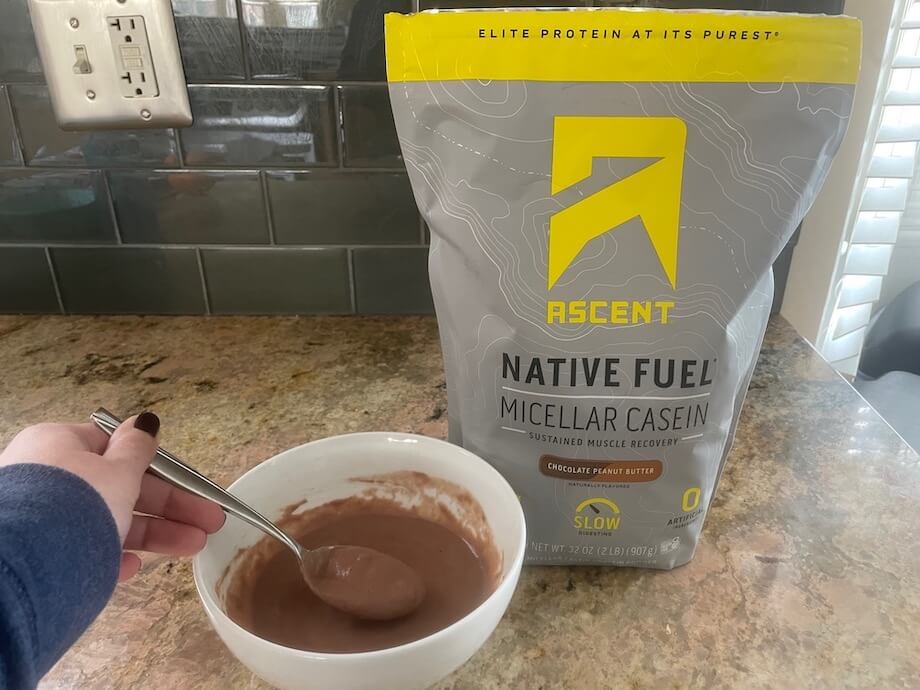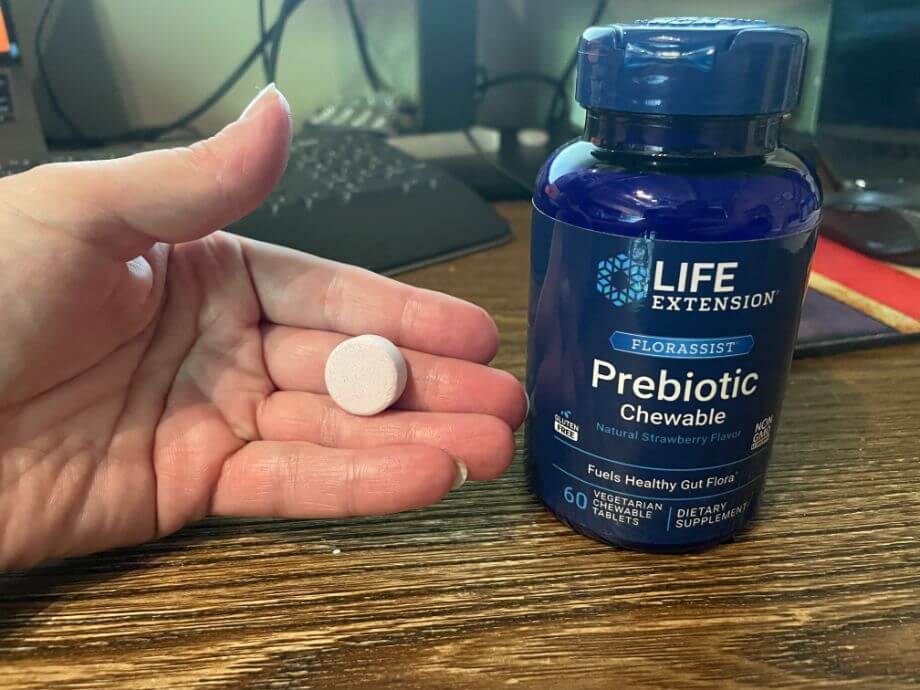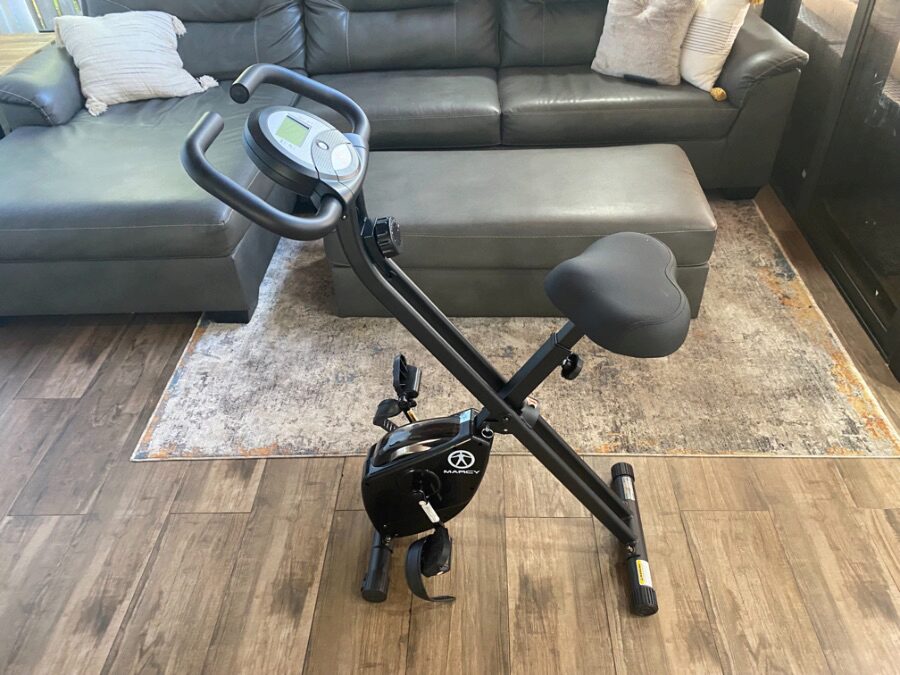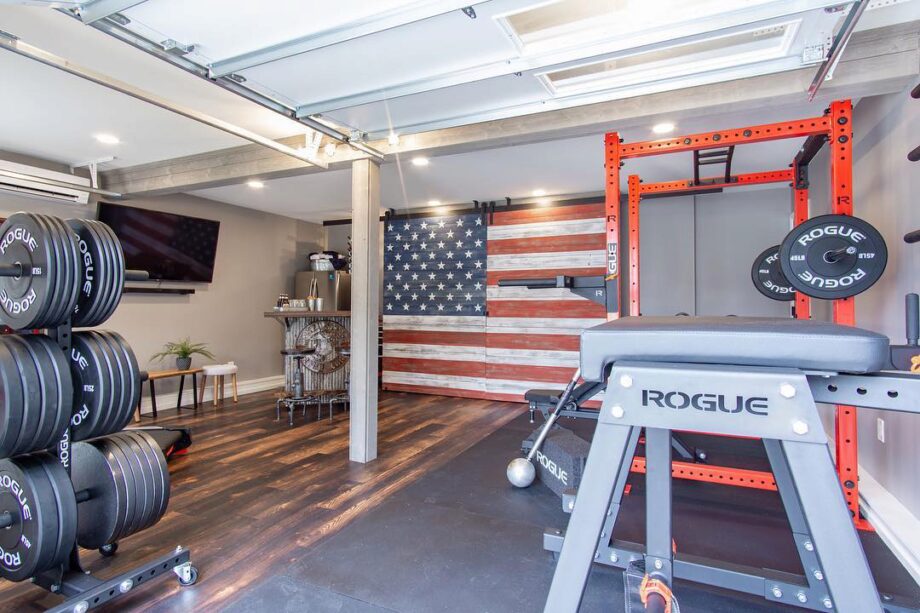Odds are, if you exercise regularly, you know the importance of a good warm-up. From doing stretches before running to hitting the best warm-up exercises, you have your pre-workout routine covered.
But what about movement during the workday? It’s important to do. Whether you work from home or at the office, most of your workday is likely spent sitting in an office chair. If you’re full-time, that’s eight hours or so per day and 40 or more hours per week. That’s a long period of time for us to sit on our glutes! Therefore, no matter how ergonomic our work area might be, we still need to move our major muscle groups throughout the day. Otherwise, we increase our risk of joint pain, strains, and even muscle damage1.
Here are 11 at-work stretches you can do throughout your workday.
RELATED: Tips for Getting a Move During the Workday
Medical disclaimer: This article is intended for educational and informational purposes only. It is not intended as a substitute for medical advice. For health advice, contact a licensed healthcare provider.
1. Neck Circles
Why do them: Did you know that sitting at work more than 95% of your working time2 is a risk factor for neck pain? In a recent study2, researchers discovered that neck pain was especially apparent with neck flexion movements (this is when you lower your chin down to your chest). Fortunately, a good neck stretch might be able to help you with this.
What’s convenient about neck circles is that you do them while seated or standing. However, it’s best to stand when you do them so you can move your legs a bit, too. Plus, doing them while seated may limit your range of motion. We definitely don’t want your head hitting the back of your chair as you move your neck around.
How to do them:
- Get in your starting position: head straight while looking forward, arms by your sides, feet hip-width apart. Maybe do some shoulder shrugs to loosen up your muscles a little bit if you’re not completely relaxed.
- Check your posture to ensure your back is straight, and proceed once you’re sure your back isn’t rounded.
- Drop your chin to your collarbone and then roll your chin towards the right shoulder. Once you feel a stretch, stop and stay there for a few moments.
- Next, lift your chin towards the ceiling and pause for a second.
- Then move your chin to the opposite shoulder, stop, and then move your chin back down to the center.
- Repeat this, but start in the opposite direction.
When you’re doing this, be sure to take your time. It’s not a race. If you go too fast, you could injure yourself, which is not the goal here!
RELATED: The Best Mobility Exercises
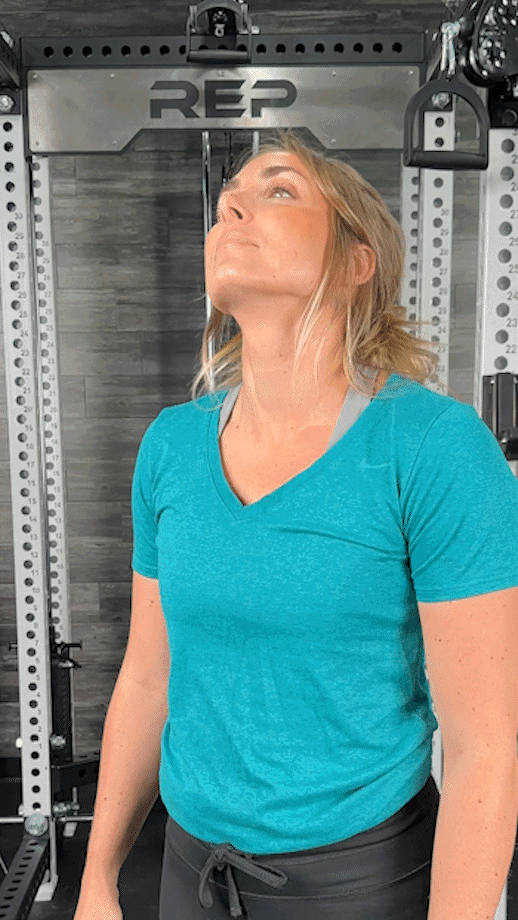
2. Seated Trap Stretch
Why do it: Your trap muscle, which is officially known as the trapezius muscle, is there to mainly provide postural support3. In fact, we use this muscle often when sitting at a computer to hold our head, neck, and shoulders in place4. In addition, the traps also help you conduct active movements, such as rotating your head, bending at your side, and raising your shoulders.
Given their many functions, it’s imperative to stretch these muscles to avoid pain and tightness. According to the Cleveland Clinic5, those who sit at a computer for several hours a day are at a greater risk of chronic pain.
How to do it:
- Sit up tall and ensure that your ears are lined up with your shoulders.
- Sit on your right hand or push it downward.
- Take your left hand, place it on your head, and use it to bring your ear to your left shoulder slowly.
- Repeat to do the left side.
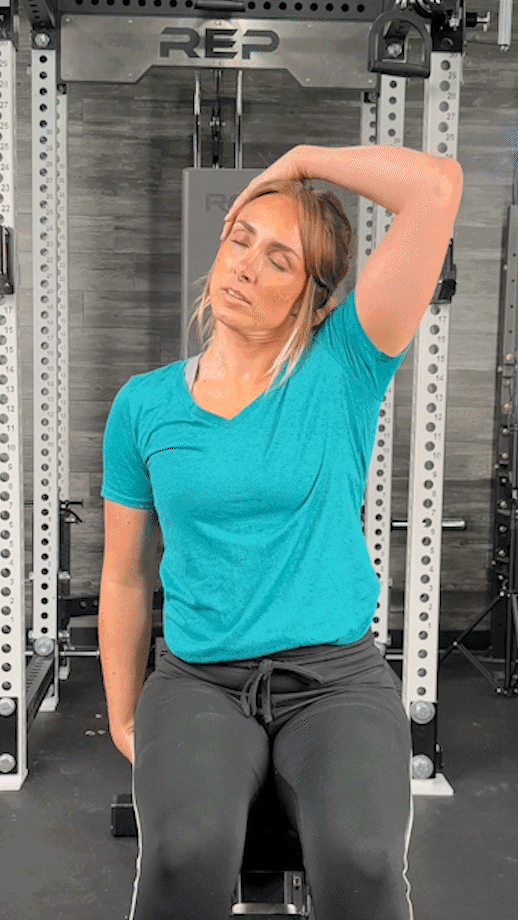
3. Overhead Tricep Stretch
Why do it: You may enjoy knocking out the best tricep exercises, but do you know the muscle’s actual function? The tricep muscle is primarily there to help extend the forearm at the elbow joint. However, it also stabilizes our elbow joint when our forearm and hand do certain movements, like writing and typing6. Considering the long periods of time we spend at work on computers, we can’t afford to have tight tricep muscles. A stretching exercise, like the overhead tricep stretch, can make a difference.
How to do it:
- Sitting or standing, roll your shoulders back and down.
- Raise your left arm in the air.
- Next, bend at the elbow and let your left hand drop to the middle of your back. Have your palms facing your back.
- Extend your right hand in the air and put your fingers on your left arm. It should be placed near the elbow.
- Push down gently if you want to deepen the stretch
- Repeat on the other side
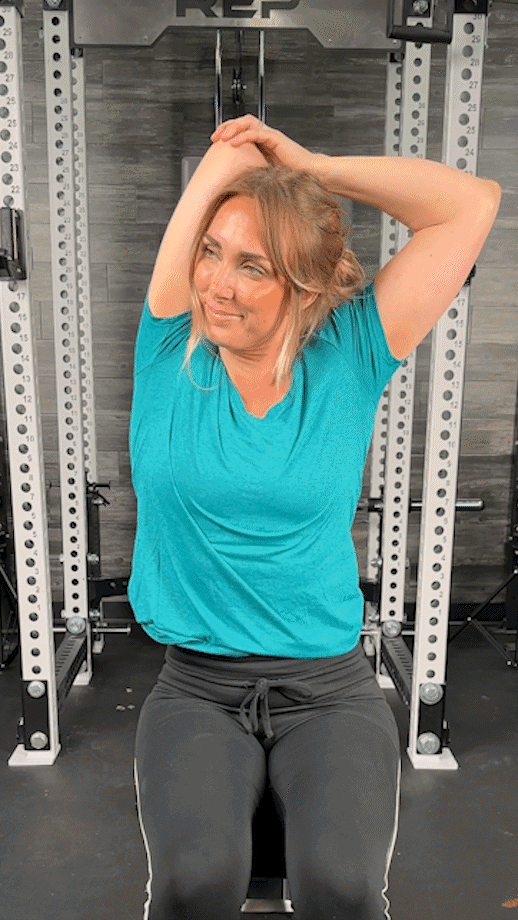
4. Cross-Body Shoulder Stretch
Why do it: Did you know your shoulder muscles support the most flexible joint in your body7? It’s true! Your shoulder joint has a pretty big role. Almost a dozen muscles, ligaments, and tendons connect at the shoulder, along with three bones8. Together, these body parts help us move our arms in many directions so we can perform a variety of different functions, which is convenient. Tight shoulders are susceptible to injury. This is why back and shoulder workouts and stretches are so important.
This desk stretch is relatively simple to do and involves widening the shoulder blades.
How to do it:
- Get in a standing position.
- Take your right arm, reach it across your body, and hold it straight. Try to make sure it stays at shoulder height.
- Use your left hand to grasp your right elbow and pull it across your body toward your chest.
- Hold it in there for 20 to 30 seconds
- Repeat on the opposite side
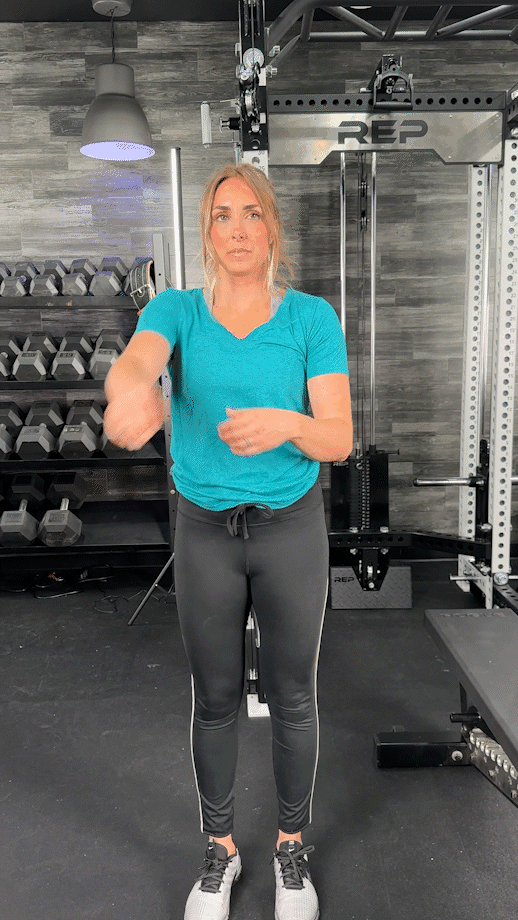
5. Wrist Circles
Why do them: Have you ever wondered if doing long days of repetitive work with your hands might be a risk factor for hand-wrist disorders? Well, one 2007 study9 found that repetitive work wasn’t necessarily a risk factor for conditions like tendonitis, peri-tendonitis, or tenosynovitis. However, hand grip force and wrist position were the main ergonomic risk factors to consider. Fortunately, doing wrist circles may be able to help you prevent wrist injuries.
How to do them:
- Make sure your feet are shoulder-width apart, your arms are at your sides, and your back is straight.
- Elevate your hands so they’re at about hip level, then fully extend them out in front of you.
- Start rotating your wrists counterclockwise, but do so slowly. The rest of your body shouldn’t be still.
- After you’ve done that for a few seconds, rotate your wrists clockwise.
- Repeat.
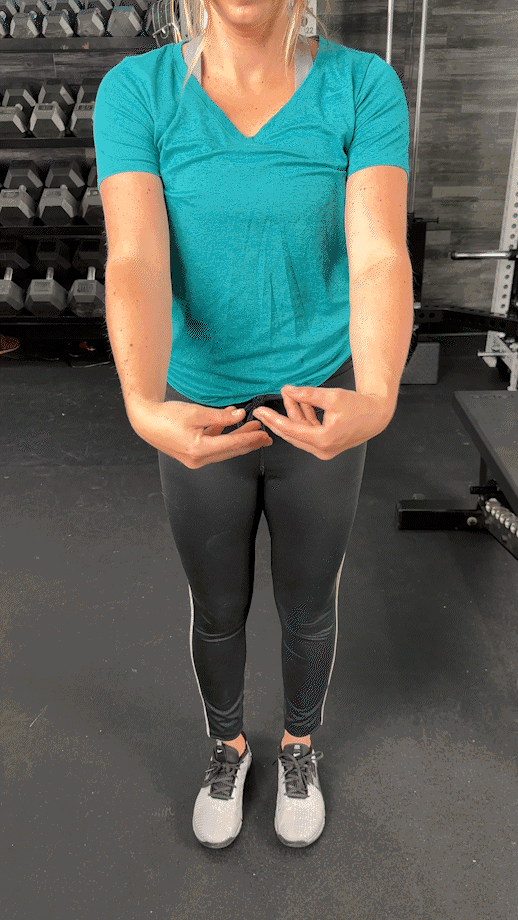
6. Seated Spinal Twist
Why do it: Sitting at a desk for a long time doing computer work can be taxing on your upper body. As a result, many people experience back pain and chalk it up as nothing. But this shouldn’t be taken lightly. A study10 found that prolonged sitting could change the low back flexion relaxation phenomenon in the lumbar extensor musculature. This can interfere with one’s spine system stability, as passive spinal tissues could become deformed and have trouble fulfilling their load-bearing responsibilities.
Thankfully, stretching may be able to prevent or provide relief to those with lower back pain11. The seated spinal twist is a good option (you might recognize it as a commonly used yoga pose).
How to do it:
- Find a chair with a hollow back and then sit sideways in it. Your left hip should be pressed into the back of the chair.
- Double-check your posture, ensuring your feet are planted on the ground, and your knees are aligned. Also, make sure that your spine is tall.
- Lift your arms up and twist towards the chair.
- Drop your arms down while keeping your shoulders parallel. Your right hand can be placed on your left knee while your left-hand rests on the chair’s back.
- Now inhale, hold for a moment, and then exhale and come back around.
- Repeat on the opposite side.
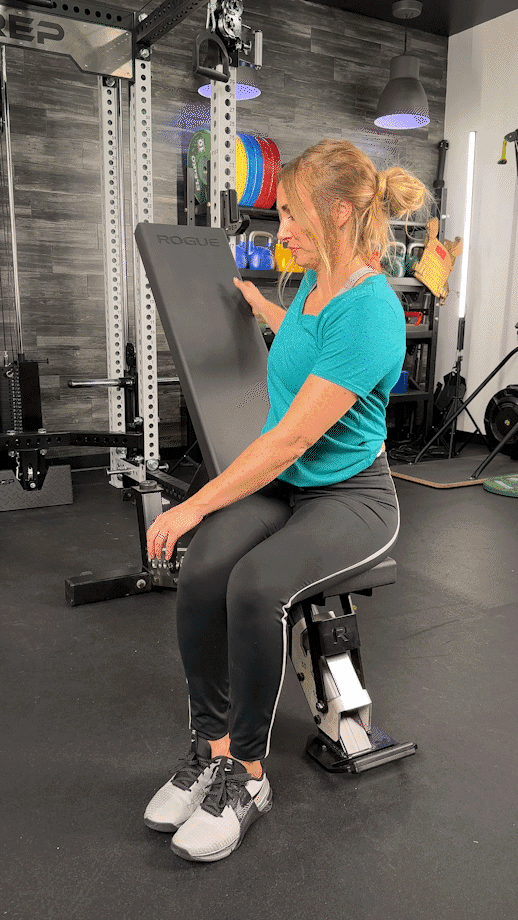
7. Seated Figure-Four Stretch
Why do it: Have you ever noticed that when you sit down for a while, your hips start to feel tight? That’s because sitting, especially for a long time, negatively affects our hip flexor muscles. Our hip flexor muscles aren’t activated when seated, so they relax in this weird, unnatural position. When this occurs repeatedly and consistently, it can cause restricted hip extension flexibility and even lead to pain in the lumbar spine12.
Stretching the hip flexor muscles enables them to continue providing lumbar spine stability. In addition, a good ol’ stretch can reduce muscle tightness and decrease your risk of injury.
How to do it:
- Your starting position should be sitting tall in a chair with both feet touching the ground. You don’t want to slump during this stretch.
- Next, keep your right foot firmly on the floor, but lift your left leg and bend it at the knee. You’ll want to place your left ankle on your right thigh, slightly above your right knee.
- Pull the left knee towards the right shoulder until you feel a stretch
- Next, hinge through the hips to bring your chest to your left knee. You should feel this stretch in your glutes and outer thighs. Make sure your back is flat.
- Repeat on the opposite side.

8. Sky Reach and Lean
Why do it: According to one study13, complaints about pain in the arms, necks, and shoulders are pretty common among computer office workers. Unfortunately, these musculoskeletal issues can lead to absenteeism from work, significant treatment costs, and a loss of productivity. But do you know what might help with all of this? A good stretch!
The sky reach and lean is one stretch that targets the shoulders, upper back, and arms.
How to do it:
- Scoot to the edge of your seat and place your feet on the ground.
- Next, clasp both of your hands together.
- Now, open up your palms, extend them out in front of you, and then raise them up above your head. Your palms should be facing the ceiling. Inhale.
- Exhale, and you lean to the right. Stay in this position for a few seconds so you can really feel the stretch.
- Take a deep breath as you go back to the center.
- Exhale and lean to the left. Stay in this position for a few seconds.
- Inhale back to the center.
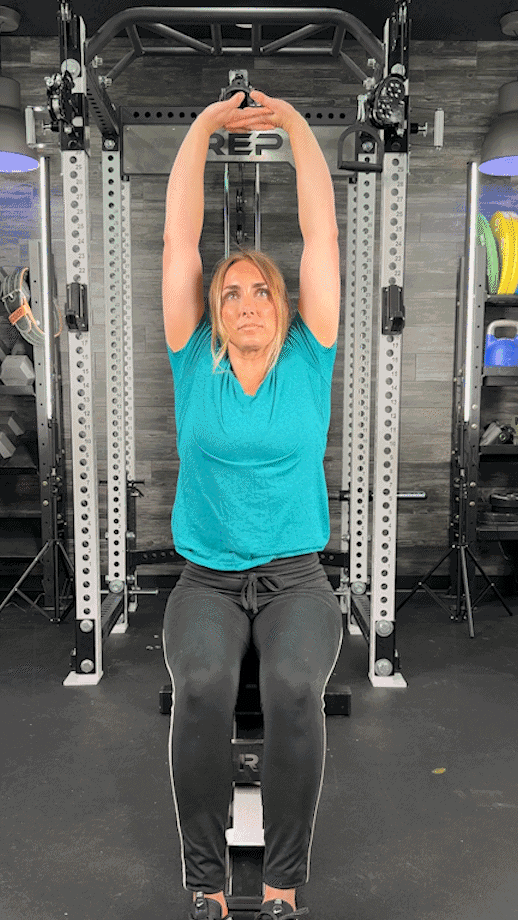
9. Chest Stretch
Why do it: Typically, when we think about the pain associated with sitting at a desk too long, we think about the lower back, neck, wrists, and shoulders. However, it turns out that chest pain could be a potential problem, too. If sitting down using a smartphone can potentially cause issues with thoracic cage function and rib cage biomechanics14, then sitting at a desk for prolonged hours during a workday could, too. Not only that, but it may also alter the length of the diaphragm and cause issues with respiratory function. Who knew posture had such an impact!?
Thankfully, chest stretches might be something you can do to help you prevent that.
How to do it:
- Sit down in a sturdy chair and intertwine your hands behind your back. Keep your elbow straight and simultaneously lift both of your arms slowly. You should feel the stretch in your chest.
- Look up and maintain this stretch for 10 to 15 seconds.
- If you feel comfortable doing so, fold forward while your hands are still clasped and hold again for 10 to 15 seconds.
- Inhale to come up and return back to a seated position.
- Repeat.
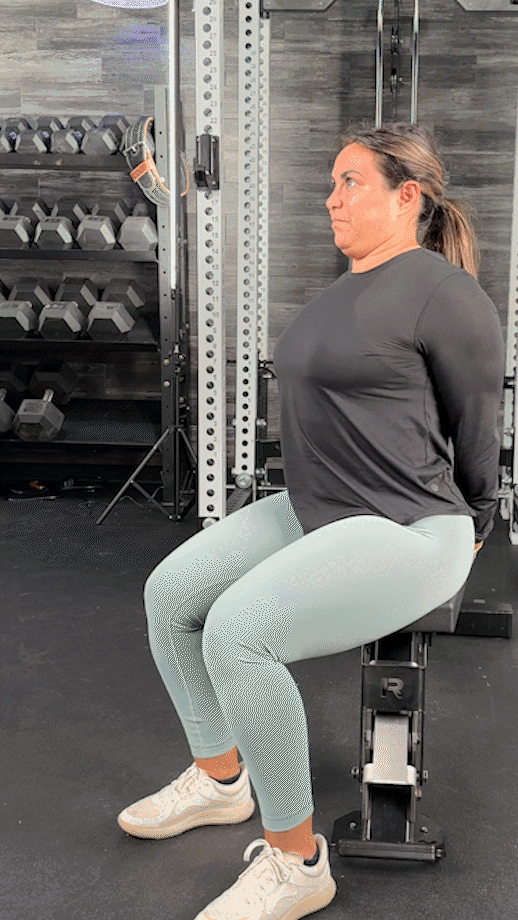
10. Forearm Stretch/Wrist Flexion
Why do it: Musculoskeletal disorders can occur from bad posture. Stretching the wrists and forearms can help keep the muscles and joints loose and ward off cramping.
In one study, researchers evaluated how using the Mouse With Your Arm™ (MWYA) methodology15 helps promote forearm support. This method suggests that you fully sit back in an office chair, use the chair’s armrest for forearm support, keep the desk and armrest height the same, and keep the mouse on the surface edge. This provides a much more neutral posture than having forearm support on a desk.
How to do it:
- Hold your right arm straight out in front of you and ensure the palm of your hand is facing up. Your right elbow should be bent.
- Next, use your left hand to hold your right fingers.
- Gently pull back the right fingers until you feel a slight stretch in your forearm muscles. Hold it like this for 10 seconds.
- Repeat on the opposite side.
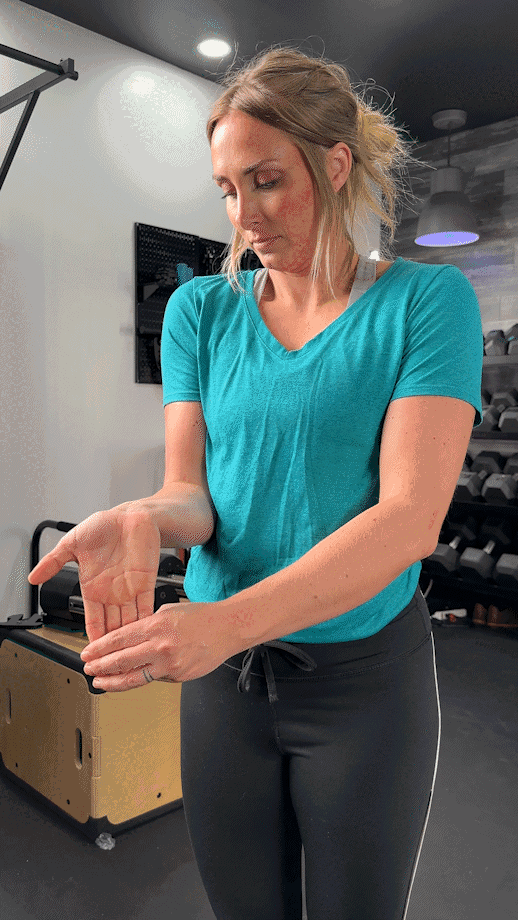
11. Chin Tucks
Why do them: Forward head posture is when your head is positioned with your ears in front of your body’s cervical spine16. This often happens when texting, gaming, or working on a computer, and it’s definitely not ideal for our bodies. Adverse effects such as dizziness, headaches, shoulder pain, and even lightheadedness can occur if you do this frequently. Chin tucks are one way to help fix forward head posture.
How to do them:
- Stand up, ensuring that your spine is tall, but your shoulders are relaxed
- Now, look straight ahead and use one of your hands to gently push your chin back like you’re giving yourself a double chin. However, be careful not to bend your neck or tilt your head up or down in the process.
- Stretch your spine up.
- Aim to hold it like this for at least 5 seconds.
- Relax and repeat.
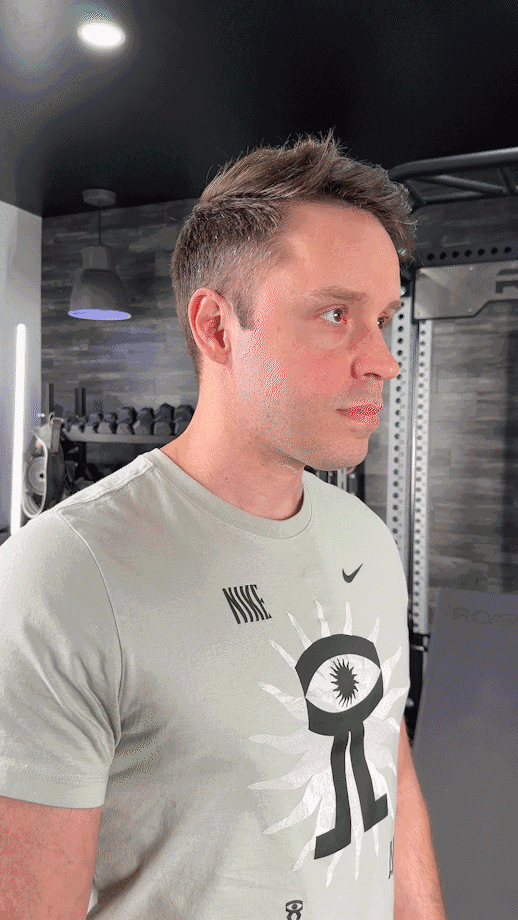
At-Work Stretches: Final Thoughts
Given that most people spend about 1,920 hours per year at work and 5-6 hours per day17 on a smartphone, it’s crucial that we stretch. One of the most significant public health problems we have today is that many of us have become sedentary. As comfortable as it may be sitting down and doing nothing in the moment, it’s anything but comfortable in the long run.
As one 2020 study18 revealed, “A sedentary lifestyle increases all-cause mortality and the risks for cardiovascular diseases, diabetes, hypertension, and cancers .”Therefore, if doing stretching exercises like hip stretches, shoulder stretches, and more can help with that – we ought to do it.
While work has to be done, we can prioritize wellness too! Therefore, consider the stretches above to help you maintain and/or improve your musculoskeletal stability. In addition, it’ll help you with your energy expenditure, which isn’t a bad thing either!
At-Work Stretches: FAQ
What Are The Benefits of A Standing Desk?
According to Harvard Health19, not only do standing desks help you burn a few extra calories than sitting, but it also reduces your risk of shoulder and back pain.
How Long Should I Stretch?
You should spend at least 60 seconds22 doing a stretching exercise. Be sure to stretch all of your major muscle-tendon groups at least two or three days per week so that you have some degree of flexibility.
What Is The Relationship Between Obesity and Desk Work?
Evidence shows that sedentary office jobs significantly increase one’s risk of total and central obesity20. Total obesity is based on body mass index; central obesity is defined as one’s waist circumference. While total obesity is dangerous, central obesity is very alarming. Extra weight in the midsection increases an individual’s risk of cardiovascular issues, high cholesterol, hormone regulation, and more21.
References
- The importance of stretching. Harvard Health. https://www.health.harvard.edu/staying-healthy/the-importance-of-stretching. Published March 14, 2022. Accessed April 21, 2023.
- Ariëns GA, Bongers PM, Douwes M, et al. Are neck flexion, neck rotation, and sitting at work risk factors for neck pain? Results of a prospective cohort study. Occup Environ Med. 2001;58(3):200-207. doi:10.1136/oem.58.3.200
- Anatomy, back, Trapezius – StatPearls – NCBI Bookshelf. National Library of Medicine. https://www.ncbi.nlm.nih.gov/books/NBK518994/. Accessed April 21, 2023.
- Theo Bodin a b, a, b, et al. Activity in neck-shoulder and lower arm muscles during computer and smartphone work. International Journal of Industrial Ergonomics. https://www.sciencedirect.com/science/article/abs/pii/S0169814118303500?dgcid=rss_sd_all. Published October 29, 2019. Accessed April 21, 2023.
- Trapezius muscle: Middle back pain, shoulder stretches, trapezius pain. Cleveland Clinic. https://my.clevelandclinic.org/health/body/21563-trapezius-muscle. Accessed April 21, 2023.
- Tiwana M, Sinkler M, Bordoni B. Anatomy, shoulder, and upper limb, tricep muscles. National Library of Medicine. https://www.ncbi.nlm.nih.gov/books/NBK536996/. Accessed April 21, 2023.
- Shoulder muscles: Anatomy, function & common conditions. Cleveland Clinic. https://my.clevelandclinic.org/health/body/21798-shoulder-muscles. Accessed April 21, 2023.
- How does the shoulder work. National Library of Medicine. https://www.ncbi.nlm.nih.gov/books/NBK554696/. Accessed April 21, 2023.
- Thomsen JF, Mikkelsen S, Andersen JH, et al. Risk factors for hand-wrist disorders in repetitive work. Occup Environ Med. 2007;64(8):527-533. doi:10.1136/oem.2005.021170
- Samuel J. Howarth a, a, b, et al. Does prolonged seated deskwork alter the lumbar flexion relaxation phenomenon? Journal of Electromyography and Kinesiology. https://www.sciencedirect.com/science/article/abs/pii/S1050641113000217?via%3Dihub. Published February 4, 2013. Accessed April 21, 2023.
- Chen HM, Wang HH, Chen CH, Hu HM. Effectiveness of a stretching exercise program on low back pain and exercise self-efficacy among nurses in Taiwan: a randomized clinical trial. Pain Manag Nurs. 2014;15(1):283-291. doi:10.1016/j.pmn.2012.10.003
- Konrad A, Močnik R, Titze S, Nakamura M, Tilp M. The Influence of Stretching the Hip Flexor Muscles on Performance Parameters. A Systematic Review with Meta-Analysis. Int J Environ Res Public Health. 2021;18(4):1936. Published 2021 Feb 17. doi:10.3390/ijerph18041936
- Ranasinghe P, Perera YS, Lamabadusuriya DA, et al. Work related complaints of neck, shoulder and arm among computer office workers: a cross-sectional evaluation of prevalence and risk factors in a developing country. Environ Health. 2011;10:70. Published 2011 Aug 4. doi:10.1186/1476-069X-10-70
- Kang KW, Jung SI, Lee do Y, Kim K, Lee NK. Effect of sitting posture on respiratory function while using a smartphone. J Phys Ther Sci. 2016;28(5):1496-1498. doi:10.1589/jpts.28.1496
- Eggleston ST. Mouse with your arm™: Facilitating forearm support using the chair armrest to prevent and mitigate musculoskeletal disorders. Work. 2020;65(3):483-495. doi:10.3233/WOR-203103
- Titcomb DA. How to fix forward head posture [guide]. NASM. https://blog.nasm.org/fixing-forward-head-posture. Accessed April 21, 2023.
- Published by L. Ceci, 14 J. Time spent on average on a smartphone in the U.S. 2021. Statista. https://www.statista.com/statistics/1224510/time-spent-per-day-on-smartphone-us/. Published June 14, 2022. Accessed April 21, 2023.
- Park JH, Moon JH, Kim HJ, Kong MH, Oh YH. Sedentary Lifestyle: Overview of Updated Evidence of Potential Health Risks. Korean J Fam Med. 2020;41(6):365-373. doi:10.4082/kjfm.20.0165
- Robert H. Shmerling MD. The truth behind standing desks. Harvard Health. https://www.health.harvard.edu/blog/the-truth-behind-standing-desks-2016092310264. Published September 23, 2016. Accessed April 21, 2023.
- Choi B, Schnall PL, Yang H, et al. Sedentary work, low physical job demand, and obesity in US workers. Am J Ind Med. 2010;53(11):1088-1101. doi:10.1002/ajim.20886
- Abdominal fat and what to do about it. Harvard Health. https://www.health.harvard.edu/staying-healthy/abdominal-fat-and-what-to-do-about-it. Published June 25, 2019. Accessed April 21, 2023.
- The ideal stretching routine. Harvard Health. https://www.health.harvard.edu/staying-healthy/the-ideal-stretching-routine. Published March 1, 2021. Accessed April 21, 2023.




